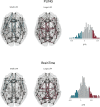A multisample study of longitudinal changes in brain network architecture in 4-13-year-old children
- PMID: 28960629
- PMCID: PMC5783977
- DOI: 10.1002/hbm.23833
A multisample study of longitudinal changes in brain network architecture in 4-13-year-old children
Abstract
Recent advances in human neuroimaging research have revealed that white-matter connectivity can be described in terms of an integrated network, which is the basis of the human connectome. However, the developmental changes of this connectome in childhood are not well understood. This study made use of two independent longitudinal diffusion-weighted imaging data sets to characterize developmental changes in the connectome by estimating age-related changes in fractional anisotropy (FA) for reconstructed fibers (edges) between 68 cortical regions. The first sample included 237 diffusion-weighted scans of 146 typically developing children (4-13 years old, 74 females) derived from the Pediatric Longitudinal Imaging, Neurocognition, and Genetics (PLING) study. The second sample included 141 scans of 97 individuals (8-13 years old, 62 females) derived from the BrainTime project. In both data sets, we compared edges that had the most substantial age-related change in FA to edges that showed little change in FA. This allowed us to investigate if developmental changes in white matter reorganize network topology. We observed substantial increases in edges connecting peripheral and a set of highly connected hub regions, referred to as the rich club. Together with the observed topological differences between regions connecting to edges showing the smallest and largest changes in FA, this indicates that changes in white matter affect network organization, such that highly connected regions become even more strongly imbedded in the network. These findings suggest that an important process in brain development involves organizing patterns of inter-regional interactions. Hum Brain Mapp 39:157-170, 2018. © 2017 Wiley Periodicals, Inc.
Keywords: DWI; MRI; brain development; brain network; graph theory.
© 2017 Wiley Periodicals, Inc.
Figures




References
-
- Andersson JLR, Skare S (2002): A model‐based method for retrospective correction of geometric distortions in diffusion‐weighted EPI. NeuroImage 16:177–199. - PubMed
-
- Basser PJ, Pierpaoli C (1996): Microstructural and physiological features of tissues elucidated by quantitative‐diffusion‐tensor MRI. J Magn Reson B 111:209–219. - PubMed
Publication types
MeSH terms
Grants and funding
LinkOut - more resources
Full Text Sources
Other Literature Sources

